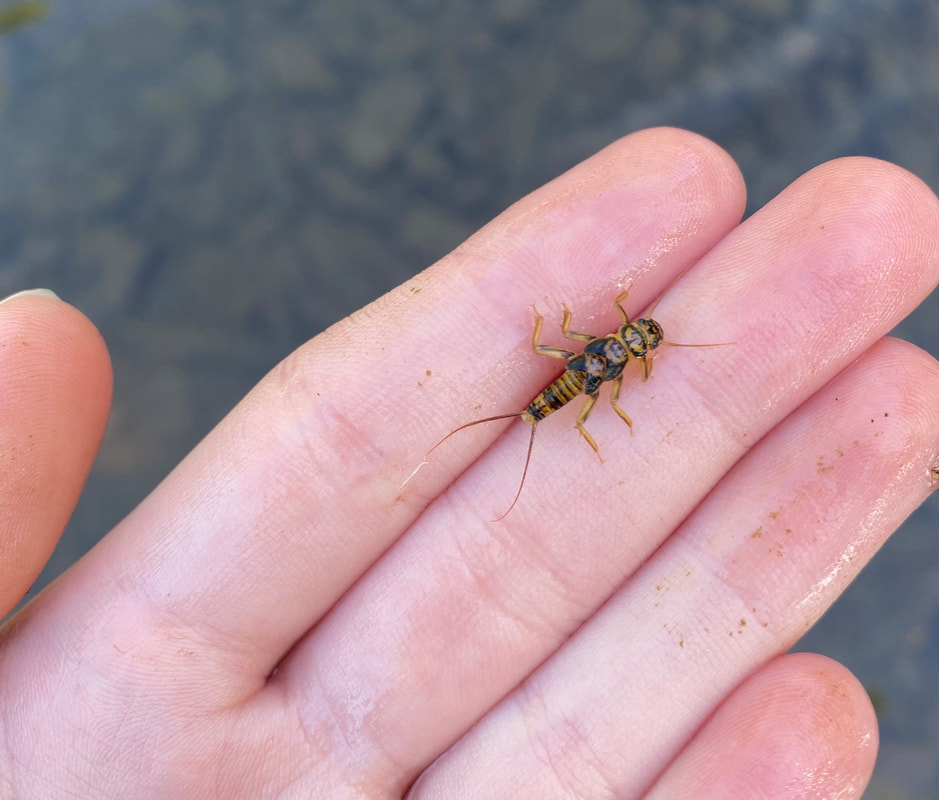Column: Collecting, counting and identifying macroinvertebrates by summer intern Peyton curley6/7/2022 A stonefly larvae taken from Penn's Creek. Riverkeeper's note: This column was provided by association intern Peyton Curley. You can contact her at curley@susqu.edu This past school year, I did a lot of collecting and identifying macroinvertebrates. Macroinvertebrates are little critters that live in ponds and streams. Just pick up any rock in a flowing stream and many different species of macroinvertebrates can be found underneath, as long as the water is clean. Macros can be found under rocks, or by kicking the substrate at the bottom of a river or stream and letting the debris flow down into a net. Some examples of macroinvertebrates are stoneflies, dragonflies, mayflies, and snails. In a few of my ecology classes, we went out to various streams near the Susquehanna University campus in Selinsgrove to collect and study macroinvertebrates.
In my Community and Ecosystems Ecology class in fall 2021, we took nets into streams and kicked the substrate at the bottom. The nets were placed against the flow, so the macros would drift right into the nets. We went to four different streams where macros could be found within the riffles, two in a pasture and two in a forest. After collecting, we went back to the lab to identify the macros we had caught with microscopes and a dichotomous key. Another helpful source that we used for identifying macroinvertebrates is macroinvertebrates.org. This website has microscope photographs of many types of common macroinvertebrates, and the photos are interactive so they are able to be viewed from different angles. After collecting macros for four weeks, we collected a total of 4 stoneflies, 15 beetles, 29 mayflies, and over 100 caddisflies. Plus, many more such as crayfish and snails. After counting the amount of macros for each sample, we found that the pasture streams had a slightly higher biodiversity than the forest streams. This was different from our hypothesis. We had thought that there would be more macroinvertebrates in the forest streams because forests tend to have a greater biodiversity. In another class I took recently in spring 2022, we also collected macroinvertebrates. For the class period, each person waded into a stream with nets, and collected macroinvertebrates for about 30-45 minutes by kicking the substrate, as well as picking up rocks. Afterward, all the macros were put in a bucket, identified, and counted. We ended up with over 100 stoneflies and almost 200 mayflies! There are a few characteristics of macroinvertebrates that can help tell them apart without using a key or microscope. Mayfly larvae generally have three tails, while Stonefly larvae have two. Also, Mayflies have one claw on each foot, while Stoneflies have two. Caddisfly larvae are usually very segmented and have many tails that look almost like hair coming out of one end. An interesting fact about Caddisfly larvae is that they build cases to hide in. These cases are made from debris at the bottom of a stream, such as tiny stones, leaves, or plants. According to the EPA, macroinvertebrates are a good indicator of the health of a stream. “Macroinvertebrates have the capacity to integrate the effects of the stressors to which they are exposed, in combination and over time”. Most are very sensitive to pollution, so they can not survive in a stream that has been contaminated. “Waterbodies in healthy biological condition support a wide variety and high number of macroinvertebrate taxa, including many that are intolerant of pollution”. Finding an abundance of macros in a stream is a good indicator that the water is clean and healthy for the organisms living in it. Mayflies, Stoneflies, and Caddisflies, are very sensitive, so finding these macros is a good sign.
1 Comment
Kathy Snavely
6/11/2022 07:15:36 am
Well done, Peyton! We look forward to having you aboard this summer. And check out this mayfly report from Lake Erie: https://www.facebook.com/photo/?fbid=566968558128819&set=a.237346334424378
Reply
Leave a Reply. |
AuthorsRiverkeeper John Zaktansky is an award-winning journalist and avid promoter of the outdoors who loves camping, kayaking, fishing and hunting with the family. Archives
April 2024
Topics |

 RSS Feed
RSS Feed